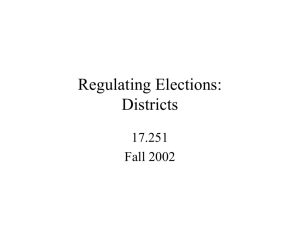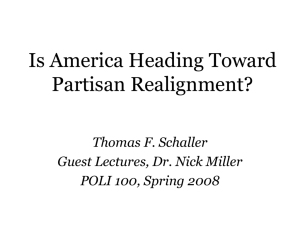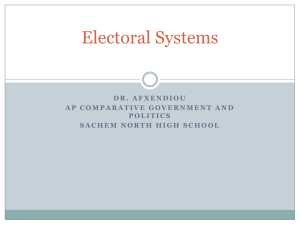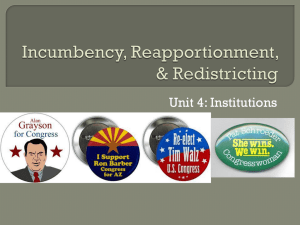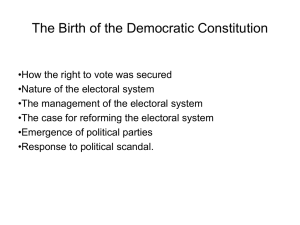Defining and measuring fairness of districting plans
advertisement
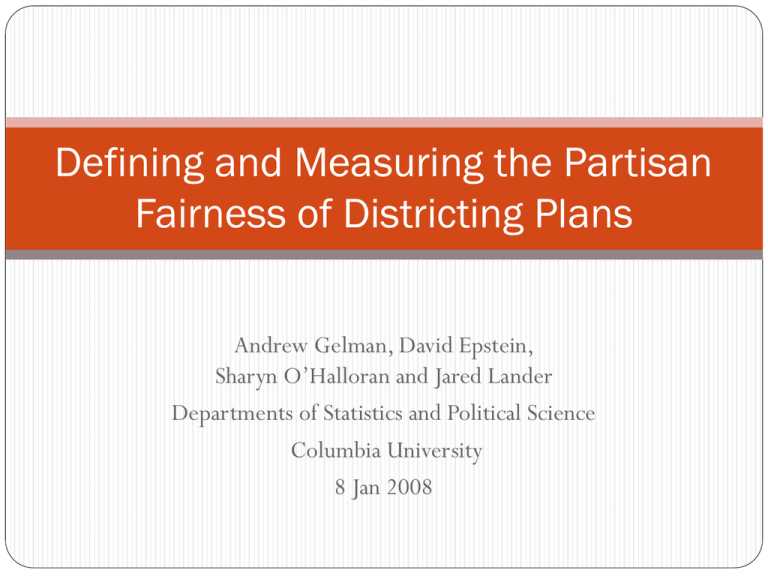
Defining and Measuring the Partisan Fairness of Districting Plans Andrew Gelman, David Epstein, Sharyn O’Halloran and Jared Lander Departments of Statistics and Political Science Columbia University 8 Jan 2008 2003 Texas Redistricting • Texas House delegation went from 17-15 Democrat in 2002 to 21-11 Republican in 2004 (while voting 61%-38% for Bush) • Is this an unfair partisan gerrymander? – Supreme Court (Kennedy) said there is no workable standard Outline: Standards of fairness • Some historical background • The proportionality standard and its problems • The seats-votes curve • The symmetry standard and its problems • Toward a comparative standard • “Fairness” matters – For the courts – For democracy – Need fairness standard to determine what’s unfair Some historical background Some historical background Some historical background “Gerrymandering” isn’t as bad as people think Gelman and King (1994b) – Empirically, redistricting decreases partisan bias and increases competitiveness – Why? Because redistricters work under many constraints But fairness is still a concern The proportionality standard Popular in Europe, via PR electoral systems “Fairness” is . . . If your party receives x% of the vote, it should receive x% of the seats This does not work, in general, with first-past-the-post systems such as the U.S. – Can win 55% of the vote in every district,100% of the seats. – In fact, can win a majority with ~25% of the votes – In general, bonus for majority party (e.g., cube law) So how do we describe the relation between voter behavior and electoral outcomes? The seats-votes curve This describes the function S(V), the seats won S for a given percentage V of the vote For a single election, calculate this as follows: – Take the vector of votes V = (V1, V2, …, V435), where Vi is the percentage of Democratic votes in district i – From this get the average Democratic vote and percentage of seats won by the Democrats – this is the actual electoral outcome – Now consider the vector V+1% = (V1+1, V2+1, …, V435+1) – I.e., a uniform partisan swing of 1% for the Democrats – Perform the same calculations for V+ x% for all values of x – This will fill out the range, yielding a nondecreasing function S(V) This is the seats-votes curve The seats-votes curve The seats-votes curve Traditionally (since Edgeworth, 1898) thought of as a deterministic function: S(V) Actually it’s probabilistic: p(S|V) Usually summarized by its expectation: E(S|V) The symmetry standard “Fairness” is . . . E(S|V) = 100 – E(S|1-V) – For example, in 2008 the Democrats averaged 56% of the vote in U.S. House races and received 59% of the seats. – This is symmetric (i.e., “fair”) if the Republicans would have received 59% of seats had they won 56% of the vote In particular, symmetry requires that E(S|V=0.5) = 0.5 King and Browning (1987): partisan bias defined as deviation from symmetry Gelman and King (1990, 1994a): empirical estimate of partisan bias by extrapolation Problems with symmetry standard • Problem 1: Need to extrapolate to 50% – Consider a state such as Massachusetts – It will never be 50-50, so how can we tell what’s fair? • Problem 2: Mixing apples and oranges – Seats-votes calculations use all districts at all points along the curve to estimate the relationship – So we use Montana to estimate Massachusetts, and vice-versa • Real problem is that the S(V) curve is designed to answer questions about the electoral system as a whole – E.g., bias (intercept at V=.5) and responsiveness (slope at V=.5) – Less useful when we’re interested in behavior away from the 50-50 mark – But each election gives us 50 data points, not just one… Toward a comparative standard • Goal: to solve the “Massachusetts problem” • Not merely an academic exercise! – Consider the 2003 Texas redistricting – Availability of computer programs will make this worse • Method of overlap – For any state, extrapolate a bit in either direction (based on historical levels of variation) – Compare a state to similar historical cases – A chain of extrapolations gets you to 50% (and symmetry) • Symmetry is thus a baseline but not always a direct standard Seats-votes curves from state congressional delegations For each state and each election, extrapolations +/- 5% using uniform partisan swing Create hypothetical elections, adding x% to Dem. share in each district, with x = -5.0, -4.9, -4.8, . . . , +4.9, +5.0 – Full implementation would also add noise (“JudgeIt”) These will overleaf with each other, creating an overall seats- votes curve with a range of variation at each point – Variation is within states with similar partisan makeups Then can obtain semi-parametric confidence intervals, taking into account state size, incumbency, etc. 1900 1920 1940 1960 1980 2008 Overall, get something that looks like a confidence band Can use this to judge proposed districting plans Texas Overall, get something that looks like a confidence band Can use this to judge proposed districting plans Discussion Traditional methods of analysis are not well-designed to assess the fairness of districting plans for states that are far from a 50-50 partisan split We propose instead the aggregation of local seats-votes curves to provide variation across states and over time These can be used to estimate normal seats-votes relationships for states with high levels of partisanship Then, define unfair districting relative to this standard See if Kennedy goes for it…
